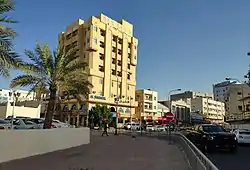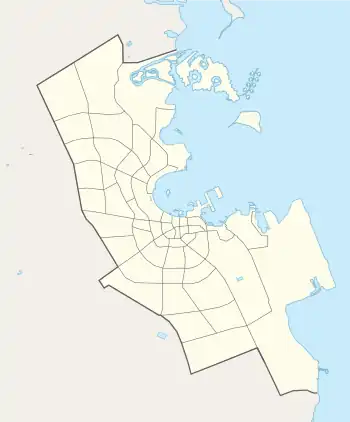Barahat Al Jufairi
Barahat Al Jufairi (Arabic: براحة الجفيري) is a district named after the Al Jufairi tribe, a highly prominent family in Qatar. Barahat Al Jufairi is a city located in the municipality of Doha.[2] Historically, it was used as a central marketplace.[3]
Barahat Al Jufairi
براحة الجفيري | |
|---|---|
District | |
 View of Barahat Al Jufairi skyline from Al Asmakh Street | |
 Barahat Al Jufairi  Barahat Al Jufairi | |
| Coordinates: 25.282679°N 51.534312°E | |
| Country | |
| Municipality | Ad Dawhah |
| Zone | Zone 5 |
| District no. | 6 |
| Area | |
| • Total | 0.09 km2 (0.03 sq mi) |
Al Ahli SC, Qatar's oldest existing sports club, was headquartered in the district at the time of its founding in 1950.[4]
Etymology
The settlement was named after a member of the Al Jufairi family, the most prevalent tribe in the area at the time of its naming.[5]
Historic landmarks
Mohammed Said Nasrallah House
The house of Mohammed Said Nasrallah, considered to be a local landmark, is located in the city. Constructed around the late 19th to early 20th century, the house has had a long history of owners. The house is modeled in typical Arabian fashion and measures 21 m by 27 m. There are eleven rooms adjacent to a large courtyard. It contains wind towers, a rarity in Qatar during the period it was constructed. Its opulent ornamental features are also distinctive when compared to those of other local structures.[3] Qatar's Department of Tourism and Antiquities restored the house in 1981.[6]
Ismail Mandani House
The former residence of Ismail Mandani is one of the most luxurious 20th-century buildings in Doha and is considered a good example of vernacular architecture. Having been constructed in 1925, the building is two-storey and features costly ornamental decorations. The building is composed of two main structures and a trapezoidal courtyard. There are 15 rooms at ground floor and 4 on the first level. Traditional construction materials were used for the building.[7]
References
- "District Area Map". Ministry of Development Planning and Statistics. Retrieved 11 February 2019.
- "2010 population census" (PDF). Qatar Statistics Authority. Archived from the original (PDF) on 2015-04-02. Retrieved 18 December 2015.
- Jaidah, Ibrahim; Bourennane, Malika (2010). The History of Qatari Architecture 1800-1950. Skira. p. 102. ISBN 978-8861307933.
- "انطلاقة مثيرة لكأس أندية قطر «لوَّل»" (in Arabic). Al Watan. 10 February 2014. Archived from the original on 22 December 2015. Retrieved 18 December 2015.
- "براحة الجفيري ملتقى التراث" (in Arabic). Al Watan. 19 April 2013. Archived from the original on 2016-03-04.
{{cite web}}: CS1 maint: bot: original URL status unknown (link) - Qatar: Year Book 1980–81. Doha: Press and Publications Department, Ministry of Information. 1981. p. 74.
- Jaidah, Ibrahim; Bourennane, Malika (2010). The History of Qatari Architecture 1800-1950. Skira. p. 154. ISBN 978-8861307933.